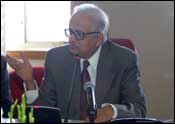RBI opts for slow and steady change; CRR cut to free over
Rs 2,000 crore
 The Monetary Policy for the second half of fiscal 2002-03 has opted for steady progress along the path of cheaper money, greater flexibility in interest rates, deregulation and procedural reforms. The Monetary Policy for the second half of fiscal 2002-03 has opted for steady progress along the path of cheaper money, greater flexibility in interest rates, deregulation and procedural reforms.
But with one caveat: the cheap money policy will continue as long as inflationary pressures stay within control.
 While the bank rate, repo rate and cash reserve ratios have been cut by 0.25 per cent each, the RBI has also removed the ceiling on export credit. While the bank rate, repo rate and cash reserve ratios have been cut by 0.25 per cent each, the RBI has also removed the ceiling on export credit.
While the CRR cut, effective from the fortnight beginning November 16, will give banks additional resources of Rs 2,000 crore (Rs 20 billion), the bank rate cut to 6.25 per cent will reduce the interest payable to banks on CRR balances since the rates payable are linked to the Bank Rate.
The 6.25 per cent bank rate, effective immediately, is the lowest in almost 30 years.
Contrary to some expectations, the RBI did not touch the savings bank rate of 4 per cent.
The ceiling rate of PLR plus 0.5 percentage points on pre-shipment credit beyond 180 days and up to 270 days and post-shipment credit beyond 90 days and up to 180 days is being deregulated from May 1, 2003.
While this runs counter to the idea of lower interest rates, the RBI believes that competition among banks will keep rates low.
Taking into account all the macro-economic developments since the last credit policy, and especially in view of the drought in certain parts of the country, the RBI has lowered the overall GDP growth projection for the year 2002-03 to a range of 5-5.5 per cent as against the earlier projection of 6-6.5 per cent.
Explaining the stance of monetary policy, RBI Governor Bimal Jalan indicated three broad goals:
- To provide adequate liquidity to meet credit growth and support investment demand in the economy while continuing a vigil on movements in the price level;
- To continue with low interest rates; and
- Encourage banks to adopt greater flexibility in the interest rate structure in the medium-term.
While the governor noted that banks were still facing resistance from depositors in accepting floating rates, he said banks must try harder to sell the idea.
Meanwhile, banks and financial institutions have been allowed to issue floating rate certificates of deposits 'provided the methodology of computing the floating rate is objective, transparent and market-based.'
The governor has frowned on the practice of regional rural banks and local area banks of paying higher interest on savings bank deposits, and the policy statement said that "RRBs/LABs and cooperative banks are encouraged not to pay any additional interest on the savings bank accounts over and above what is payable by commercial banks."
"Moreover, cooperative banks should not be paying interest on current accounts. And sponsor banks have been asked to avoid paying interest on the current accounts maintained by RRBs with them. The operative words were encouraged, and discouraged, signalling the fact that the RBI is not inclined to discipline banks by executive fiat."
In the case of export credit, however, the RBI decided that while it would deregulate interest rates on pre-shipment credit above 180 days, it has stopped short of going the whole hog and abolishing the ceiling rates on pre-shipment credit up to 180 days and post-shipment credit up to 90 days.
This will come only in phase two. To give exporters greater flexibility, the RBI has announced that exporters will be allowed to prepay pre-shipment credit - subject to mutual agreement between the exporter and the banker.
For this purpose, balances held in the EEFC account of the exporter can also be used.
Analysing the credit trends in the year so far, the RBI said that bank credit increased by 6.6 per cent up to October 4, 2002, excluding the impact of mergers in the banking sector. (Mainly, the ICICI-ICICI Bank merger).
This marks a deceleration from the 6.8 per cent reported in the corresponding part of 2001.
But since food credit declined this year in the wake of the drought, the overall increase in bank credit went more to the non-food sector, up 7.4 per cent compared to 5.2 per cent last year.
This suggests an improved outlook for industrial revival this year.
Noting that annual inflation, as measured by the Wholesale Price Index (WPI) was just 2.8 per cent on a point-to-point basis as on October 12, 2002 (as against 3 per cent a year ago), the RBI said that "the relatively lower inflation rates in the recent period have helped in creating a favourable environment for moving towards softer interest rates in the economy."
But, the RBI said the "softer interest rates prevailing in the economy in the recent period, is sustainable in the medium/long term if the rate of inflation continues to be low."
"An important objective of monetary, fiscal and supply management policies must be to ensure that there is no resurgence of inflationary pressures in the economy."
ALSO READ:
Monetary & Credit Policy 2002-2003
More Money Headlines
Tell us what you think of this report
|